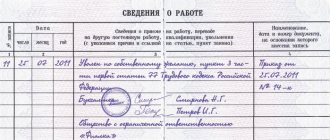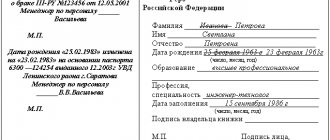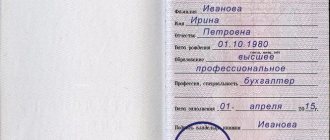Regulations governing the introduction of corrections
When drawing up a work book (insert), correcting the specified information, you should adhere to the principle: you cannot make any corrections on top of existing entries, as well as cover up or cross out unreliable data.
The necessary amendments are made as follows: the erroneous entry is considered invalid, and the correct information is placed on the next line below, starting with the serial number.
Important
Maintaining and filling out work books, including inserts for them, must meet the requirements of the Instructions approved by Decree of the Ministry of Labor of the Russian Federation dated October 10, 2003 No. 69, as well as the Rules approved by Decree of the Government of the Russian Federation dated April 16, 2003 No. 225.
https://youtu.be/Oo551UEhbiQ
What the law says
Government Decree No. 225 “On Work Books” is the only law, in addition to the set of registration rules, that dictates the requirements for making changes to workers’ books.
https://youtu.be/DZmnN55WboQ
The resolution is accompanied by inserts approving the appearance of work books (issued after the entry into force of the 2004 changes), as well as the rules for filling them out. From the point of view of the law, the changes in this document are completely legal. They are standard practice, because adjustments from the employer are necessary in a number of cases.
What does the law say about canceling an entry in a work book?
The following are devoted to resolving the issue of incorrect entries in work books:
- section three of the Rules for maintaining and storing work books, producing work book forms and providing them to employers, approved by Decree of the Government of the Russian Federation of April 16, 2003 N 225;
- section one Instructions for filling out work books, approved. Resolution of the Ministry of Labor of the Russian Federation dated October 10, 2003 N 69.
First of all, it is necessary to understand that it is impossible to simply cross out or cancel an entry in the work book about work, transfer, award or dismissal. There is only one legal way to cancel it - invalidation by making an appropriate entry about it.
The employment record is invalid: how to fix it
If incorrect information is found in the text, the specialist enters corrective information, for which he indicates:
- Serial number of the record;
- In gr. “Date”—the date the recording was made in Arabic numerals
- In gr. “Information about work” - the name of the company (full and abbreviated), an incorrect entry is invalidated by the phrase “entry No. ... is considered invalid ” , new information is entered;
- In the column “Name, date and number of the document justifying the entry,” the number and date of the order confirming the veracity of the new information is recorded;
- Position and signature of the specialist who made the correction.
This is the algorithm for corrections when an inaccuracy is made by a performer in one organization. For example, if there is an error in the title of the position (sample No. 1), the number of the personnel order or its content (sample No. 2).
Entry in the employment record about the invalidity of the entry: sample No. 1
When changes are made to the work book
A limited number of people can make entries in the work book and correct them. Usually, in an organization, by order of the manager, a responsible person is appointed who is assigned these functions. The list of positions that can be appointed by order has not been established. Therefore, the manager himself has the right to appoint and vest such powers. Typically this is a HR or accounting specialist. In the case of an organization with a very small staff, the manager can make entries in the work book himself.
Errors are most often discovered during internal audits of personnel documents and then corrections are made by the responsible person. But situations are also common when a citizen discovers an inaccuracy after he has received the work book in his hands. Let's look at typical cases and what to do.
1. The owner of the work record book discovered an error in the information on the title page.
On the title page, according to the Instructions for filling out the book, it is possible to make only the following changes:
- related to changes in personal data (full name, date of birth). In this case, the original information is crossed out with one line, new information is written next to it, and a record is made on the inside of the cover about the document on the basis of which the changes were made. It is certified by the position of the responsible employee, the signature and seal of the organization;
- about education and specialty. In this case, the previous data is not crossed out, but the new entry is entered next to it. This addition does not require certification.
If a work book is being drawn up for the first time and an error is made on the title page, then such a form will be considered damaged and must be replaced.
2. The owner of the work book discovered an error in information about work or awards.
In this case, you should proceed as follows:
- submit an application to the organization that made the error in the entry with a request to make corrections;
- request from the organization where the citizen worked and whose employee made an incorrect entry in the book for clarifying documents (copies of orders, employment contracts, etc.). With these documents, apply for changes to the employer for whom you currently work;
- request copies of orders, employment contracts, extracts, etc. in the city archive, if the organization has already been liquidated and the documents have been deposited in the archive.
General rules for correcting incorrect entries in the work book
The primary postulate of maintaining a work record book: nothing should be crossed out or covered up! Any corrections are made only by invalidating the erroneous entry.
Important! This postulate does not apply to the contents of the title page, since filling out this part of the work book is regulated by separate rules. The error is corrected by the employer who made it or the organization in which the citizen works at the time the incorrect entry was discovered
In the second case, the employee must submit papers justifying the correction and coming from the former employer or other official organization. According to the rules governing the procedure we are studying, only original documents are allowed, not copies.
The error is corrected by the employer who made it or the organization in which the citizen works at the time the incorrect entry was discovered. In the second case, the employee must submit papers justifying the correction and coming from the former employer or other official organization. According to the rules governing the procedure we are studying, only original documents are allowed, not copies.
If the former enterprise is reorganized, then the legal successor corrects the incorrect entry or submits the foundation paper. If it is liquidated (this also applies to employers - individual entrepreneurs), then changes are made at the current place of work, and at the request of the employee, the employer is obliged to help in collecting the necessary documents.
Any sources other than witness testimony are used for evidence. The latter are taken into account if the changes are due to court decisions or there has been a massive loss of work books by a separate organization (paragraph 2, paragraph 29, section III of the Rules).
Who can contribute
The employee is not authorized to independently make entries (hereinafter also referred to as marks, inscriptions), correct or supplement them.
Introduction, modification or addition are carried out by the employer at the main place of work.
For these purposes, the head of the organization, by issuing an order, appoints a responsible person (usually a specialist from the human resources department).
After identifying the person authorized to make the appropriate adjustments, the citizen needs to identify a specific employer who has the right to invalidate the mark.
All necessary information is given in clauses 26 – clause 28 of the Resolution:
This is also important to know:
Calculation upon dismissal: payment terms, calculation, calculator
| What needs to be changed | Where to contact |
| Full name, date of birth, add or change education, profession, specialty | To the employer at the current place of work, presenting him with the relevant substantial document - passport, birth certificate, marriage certificate or dissolution of marriage, etc. |
| Incorrect mark contained in the “Work Information” or “Award Information” section | At the request of the worker - either to the employer who made this incorrect entry, or to the employer at the current (last) place of work. In the latter case, you need to provide an official document from the employer who made the mistake |
| Incorrect mark if the employer who made it was reorganized | To the successor of the reorganized company |
| An incorrect entry if the employer who made it was liquidated | To the employer at the current (last) place of employment, presenting him with an official document confirming the liquidation |
How to correct inaccuracies in a work book
In order to make adjustments to the work book or cancel a previously completed mark, you should adhere to the following algorithm:
- Correction of the employee’s personal data is carried out by the employer at the place of work where they were entered.
- Reliable information is entered only on the basis of original documents.
- In the event of a reorganization of a legal entity, the successor organization is capable of correcting an improper entry. In case of individual liquidation or liquidation of an enterprise, amendments are made by the current employer.
Methods for adjusting entries in labor records
If a mistake was made when drawing up a new labor document, then this document is destroyed (written off according to the act), and a new one is issued in its place. If there is an inaccuracy in a valid document, the error must not be covered up, corrected or erased. Let's consider options for correcting the work book of the 2019 sample, which is presented below. The correction is made by making a new entry after the erroneous one.
Correction by crossing out irrelevant information is allowed only on the title page and page 33 of the work book. The title page contains information about the owner of the document: full name, date of birth, education, specialty. Changing this information, including correcting the date of birth in the work book, is carried out by crossing out existing information and entering new information. The inside cover contains information about the document on the basis of which the entries are adjusted. They must be certified by the signature of the responsible person and the seal of the organization.
How to correctly make an entry in a work book if a mistake is made
Inaccuracies are corrected in accordance with documents confirming the need for corrections. The method of correction depends on the type of error. There may be inaccuracies when filling out the document for the first time, in a certain part of it, as well as errors associated with maintaining the form as a whole.
Irregularities during initial filling
If a mistake is made when filling out the paperwork for the first time, there is no need to make corrections. It is worth taking a new form and making entries again. The damaged form is destroyed. The cost of the form is paid by the organization if the damage to the paper is not the employee’s fault.
An incorrect mark during the initial design of the insert is also not corrected. A new document is being filled out. If the series and number of the insert are already entered in the work book, the mark needs to be corrected. Information about the invalidity of the insert under the specified number is entered on the inside cover. The date is written down, the signature of the responsible person and the seal are affixed. After this, the data of the new insert is entered.
Inaccuracy in filling out the employee’s personal data
According to paragraph 26 of the “Rules for maintaining and storing work books,” changes in the employee’s name, surname, or patronymic, education and profession are made on the basis of a document confirming the new information. This could be a marriage or divorce certificate, an identity document, a birth certificate or other paper. On the title page in the date of birth, changes are made in the same way.
The information entered must fully comply with what is stated in the supporting document. If the clarifications are not provided in full, only the data that is present in the document is entered. You should request the originals of the papers, information from which is entered into the subordinate’s book. If the originals are not available, notarized copies will replace them. In general, the words of witnesses are not considered grounds for correcting the record (except in the case of legal proceedings and mass loss of work records as a result of an emergency). This is stated in paragraph 29 of the Rules.
Sample fix:
The correction is made by the responsible person at the last place of work. You need to change the data on the title page. According to paragraph 2.3 of the Instructions, incorrect wording should be crossed out with a straight line. The correct information is entered in the appropriate line, and information about the supporting document is written on the inside cover. The signature of the responsible specialist or employer, as well as the seal of the organization, is required.
Clause 2.4 specifies the procedure for making changes to the columns with information about education, profession and specialty. The information must be corrected in the appropriate lines or supplemented with clarifying information. A record is also made of the document on the basis of which the correction is made.
Errors in job information
Clause 30 of the Rules and 1.2 of the Instructions clarifies that correcting inaccurate employment data by crossing out an erroneous entry is not permitted. The inaccuracy is eliminated by invalidating the entry and creating a correct one. The invalidity entry is made as follows:
- Column 1 indicates the next sequential number;
- the date the corrections were made is written;
- the phrase “The entry numbered... is considered invalid” is written;
- the correct wording is entered;
- in the next column, fill in the details of the document from which the initial information was entered
If the dismissal mark is invalid, enter “The entry number... is invalid, dismissed (the reason is indicated)” or “The entry number... is invalid, reinstated to the previous job.” Changes in dates and numbers are also made by invalidating the entry.
Inaccuracies that arise in the order itself, on the basis of which the entry is made, are corrected after drawing up a new order indicating the correct details. Examples of fixing similar errors can be found below.
Errors in award information
Problems with award information are rare because the awards themselves occur infrequently. An error made is corrected by invalidating the entry and making correct corrections.
The negligence examiner may enter the work details into the award details entry. This happens when the space allocated for job information has run out. In this case, an insert should be drawn up in the work book, and the erroneous entry should be declared invalid in the general manner.
An example of correcting an error on the title page of a work book
Below are examples of common errors introduced by a manager or HR officer.
Correction of date of birth
Blots and errors may be found in the date of birth, which is indicated on the title page. An employer who notices an inaccuracy or the impossibility of unambiguously interpreting any of the figures may cross out the date and make a correct entry above it. This right follows from clause 26 of the Rules for maintaining work books. In this case, on the back cover there must be a link to the document from which the date of birth was taken. This is a passport or birth certificate.
Fill date correction
The title page indicates the date of completion or opening of the work book. In it, a personnel employee most often makes a mistake at the turn of the years. For example, with the onset of the new year, when they have not yet had time to rebuild, they indicate the old year. Such a discrepancy can only be detected by comparing the first entry in the work book with the date on the title page.
It can be corrected by the employer who issued the work book, or he will issue a certificate for recording the movement of Labor Code forms. Only on the basis of such a certificate will the employer for whom the citizen currently works be able to make changes.
Changing the last name in the work book: sample 2019
Above we described how changes related to the employee’s personal data are made. When changing the surname, the old one is crossed out with a solid line and the new one is written next to it.
Information about the change of surname and foundation is entered on the inside of the cover. The record must be certified as follows:
- the position of the employee responsible for maintaining work records is indicated;
- the responsible person signs;
- the organization's seal is affixed.
Sample fix
| The surname “Petrova” was changed to the surname “Sidorova” on the basis of a marriage certificate dated 04/20/2019 IV-MU N 123456, issued by the Kutuzovsky department of the Civil Registry Office of the Moscow Civil Registry Office HR specialist Kirillova Seal (Signature) | Coat of arms of the Russian Federation LABOR BOOK TC N 1594567 | ||
| Surname | Petrova Sidorova | ||
| Name | Anna | ||
| Surname | Leonidovna | ||
| Date of Birth | 23.04.1987 | ||
| Education | higher professional | ||
| Profession, specialty | jurisprudence | ||
| Date of completion | 20.02.2019 | ||
| Book owner's signature | Petrova | ||
| M.P. | Signature of the person responsible for maintaining work records | ||
| Nazarenko | |||
How to cancel a dismissal entry in a work book?
How to cancel an entry: step-by-step instructions and a sample order.
It is not uncommon for an employee to decide to quit.
As required, in accordance with current labor legislation, he wrote a letter of resignation two weeks in advance and submitted it to management.
And now the manager has already signed an order to dismiss this employee at his own request; the HR department has already entered information about this into the work book.
Is it possible to cancel a dismissal entry in the work book? Is this acceptable?
In the employee’s work book, the employer (represented by the responsible employee of the HR department) enters information about:
- employee;
- work;
- awards for this employee.
The procedure for making adjustments to these sections is somewhat different and is established by special Rules and Instructions, which are approved by Decrees of the Government of the Russian Federation.
Cancellation of entering information about the dismissal of an employee is acceptable.
But for this there is a special algorithm and special rules. For example, you cannot simply take and cross out data that is no longer relevant (as well as records about a transfer, hiring, or awarding an employee)
.
In accordance with the laws governing labor relations, if an employee decides to terminate relations with a given employer and writes a statement about this, then within two weeks he may well change his mind and withdraw his statement back
. The basis for this is Article 80 of the Labor Code of the Russian Federation.
If the application is withdrawn by the employee, then they do not have the right to dismiss him, unless during this time a new employee (invited from the previous place of work in writing) who has already been transferred from another place of work has not come to replace him (Article 64 of the Labor Code)
.
Since an employee may still change his mind after filing an application for termination of employment, all dismissal documents are usually prepared at the last minute. But it is still possible that the employee decides to stay at his old job exactly the day before the two-week period expires.
Free legal consultation We will answer your question in 5 minutes!
Free legal consultation
We will answer your question in 5 minutes!
Ask a Question
Call: 8 800 511-39-66
Regulatory legal documents regulating, in addition to the Labor Code, the issues of canceling erroneously entered information, are represented by the relevant Decrees of the Government of the Russian Federation on maintaining labor books
.
How to properly make a notice of dismissal invalid?
Firstly
, it is necessary to cancel the order to terminate the working relationship with the employee in connection with his dismissal by signing a new order canceling the previous one.
Secondly
, obtain from the employee a statement that he is recalling his previous statement in which he asked to dismiss him, and then take the employee’s application for termination of the working relationship with him and write on it that it is canceled due to the receipt of the application for his recall.
Third
, entries on the invalidity of information on termination of employment relations are entered into the book on the basis of an order to cancel the previous order. The entry on the termination of the working relationship is crossed out once, and the responsible employee of the HR department must sign next to it.
Cancellation of an unresolved termination of a working relationship with an employee is carried out like this:
- in column “1” you need to put a number that will continue the numbering in the book (next to the serial number of the previous entry);
- in column “2” you need to put the date on which the current entry is made;
- in column “3” an entry is made with the following content: “Entry No. ... is invalid,” and then a valid entry must be made;
- in column “4” they put the order number (this is the order on the basis of which the currently irrelevant information about the employee’s dismissal was removed).
An example of canceling a dismissal entry in a work book:
Ignoring the rules on filling out work books, including the rules on correcting invalid information in them, entails liability under Article 5.27 of the Code of Administrative Offenses for violation of labor legislation
.
The sanction of this norm involves issuing a warning to the person responsible for this violation or a fine.
If, for example, an employee of the HR department (official) is found guilty of incorrectly completing the cancellation of an entry in the work book, then the fine for him will be 1000 - 5000 rubles, and if an individual entrepreneur is found guilty, the amount of the fine will be the same; and if a legal entity (organization) - the amount of the fine will be 30,000 - 50,000 rubles.
Thus, the employer (represented by the personnel department employees) needs to carefully monitor how documentation relating to its employees is maintained, including work records
, how information is entered into them and how it is corrected if necessary.
When can a work book be invalidated?
There are several situations when a Labor Code can be invalidated:
- errors were made during initial filling;
- pages are torn out of the document or they are glued together;
- the document number is blurred or unclear;
- the document contains information (words) not related to the employee’s work activity;
- clarifications in the sections “Information about work” and “Information about awards” are made by crossing out, covering with a proofreader, or in any other way not provided for by law.
In these cases, the employee can receive a duplicate document. All correct information is transferred to it; information about incorrect entries is not duplicated.
What can't be fixed
It is important to note that the dismissal record must be certified by the seal of the organization. If this was not done on time and further information about employment in another organization follows, then it will not be possible to correct it. It will be quite difficult to enter information about the person responsible for maintaining the book at the previous place of work.
Therefore, it is possible to confirm the authenticity of the dismissal record using a clarifying document. It must be requested from the organization that made the mistake. Otherwise, it will not be possible to confirm the period of work there.
Errors in the form of typos on the title page are quite difficult to correct, since there are indications that corrections and additions are made on the basis of documents. Therefore, many personnel officers decide to leave everything as it is, if the error is not critical. But then the citizen will subsequently have to prove that the document belongs to him. Therefore, the responsible person must fill out the title page as carefully as possible and let the employee review it.
Fact
Please note that a work book in which entries in the title page and information about the work are incorrectly corrected is considered invalid.
Cancellation of an entry in a work book: features of making changes
Incorrect information can be found in any section of the document or on the title. Despite the fact that the law dictates the same methods for correcting information, we will consider different cases of possible errors.
Following the general instructions, inaccuracies made by the personnel officer at the stage of document preparation automatically make the new book invalid. It must be destroyed. If an error is discovered in an already valid book, it is necessary to declare the invalidity of the previous entry with a new entry. You cannot cross out an inaccurate entry or use correction fluid. Let's figure out how to remove an entry from the work book in accordance with the instructions.
Responsibility for errors in filling out the form
Clause 45 of the Rules indicates the employer’s responsibility for maintaining, recording, storing and issuing employment documents. Management by order (or instruction) appoints a person whose duty will be to make and change records.
According to Art. 5.27 of the Code of the Russian Federation “On Administrative Offenses” No. 195-FZ dated December 30, 2001 (last edition of the document - April 3, 2018), violation of the current legislation entails a fine in the amount of:
- for officials - from 1000 rubles. up to 5000 rub.;
- for individual entrepreneurs – from 1000 rubles. up to 5000 rub.;
- for a legal entity – from 30,000 rubles. up to 50,000 rub.
You can avoid mistakes in paperwork by being attentive to the duties performed. Knowledge of the rules and basic legislative acts will protect you from fines and sanctions from the state.
Additional questions
The employee is asked to create a work book if he has another one
In rare cases, an employee asks to issue a new document if he already has a valid book. A few examples of employees who may want to create an additional form:
- a teacher who teaches classes at different universities;
- a doctor who sees patients in both private and public clinics;
- security guard employed at 2 places of work on different shifts
An employee can create several documents, expecting material benefits from different organizations. The law does not clearly prohibit such actions. However, it can be argued that only one copy is legal. Art. 282 of the Labor Code of the Russian Federation provides a clear definition of the concept of “part-time work”. Only one place of work can be the main one.
A citizen is listed as a part-time worker on the basis of an agreement with the organization. The Labor Code also guarantees support for citizens combining work with study, but only at their main place of work. One place of work is also taken into account in relation to benefits for workers in the Far North and hazardous industries. Information about part-time work is entered into the subordinate’s papers. The number of organizations in which a person can work part-time in his free time from his main job is not limited by law.
Registration of a duplicate
If an employee's book is lost, he must report it as soon as possible. The employer must issue a duplicate within 15 days from the date of application.
The duplicate includes:
- information provided at the last place of employment;
- data on total work experience before joining the staff
If the lost form contained a mark that was declared invalid, it will not be duplicated in the new copy. The total length of service is indicated in summary, without specifying the organizations in which the subordinate was registered and the reasons for dismissal.
A duplicate is issued if the employee’s book is lost or damaged. A duplicate may be issued if the original version contains an erroneous entry about the dismissal or transfer of an employee. In this case, erroneous information is not entered into the duplicate.
Errors related to information about past jobs must be corrected by the organization that made the mistake. If the organization is reorganized, the problem is solved by the successor. In the event of liquidation of the company, the correction is made by the responsible person at the current place of employment.
Information about the probationary period is not included in the list of employment of the subordinate, since the employee is not yet officially working in the company, and the law does not indicate the need to record such data.
When making notes, both the full and abbreviated name of the employer is written down in the document. If an error is made in the name of the organization (even if it concerns only the abbreviated name), a note is made in the documentation with up-to-date information.
According to clause 35 of the Rules, the seal of the organization, as well as the signature of the responsible person, certifies all records of this organization in the form upon dismissal of an employee. The owner of the work book signs each entry. The seal is also placed on the title page. If the stamp is placed upside down, this is not considered a violation. The notice of dismissal is made on the day the employee is dismissed. If a subordinate went on vacation before leaving the organization, the date of the last day of vacation (also the date of the last working day) is entered in column 3. The reason for dismissal must include a reference to the clause and article of the Labor Code of the Russian Federation.
Other information included in the form
Similar to information about work, column 3 of the form includes information about:
- taking advanced training courses, retraining and special training;
- receiving a new rank (category);
- part-time employment;
- the time spent in places of deprivation of liberty is not subject to offset in the total work experience;
- period of military service or service in internal affairs bodies;
- restoration of continuous service










